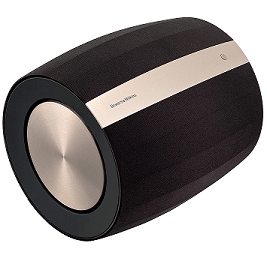Having a subwoofer in your music or audio system adds a significant boost to the bass and also improves the overall quality of the sound. Wireless subwoofers improve the richness of your sound system without the hassle of dealing with cables. They are easy to set up, and placement is also very convenient.
If you’re in the market for a good wireless subwoofer, in this roundup guide, we’ve evaluated the top options you can pick. No matter your budget and room size, there is something for you.
Wireless Subwoofers Comparison Table
| WIRELESS SUBWOOFER | RMS* | DRIVER | DIRECTION | FREQ.** | DIMENSIONS |
|---|---|---|---|---|---|
| Klipsch R-12SWi | 200 | 12″ | Front-Firing | 29 – 120 Hz | 14″ x 18.5″ x 16″ |
| Sonos Sub Mini | Unav.*** | 6″ X 2 | Inward-Firing | Unav.*** | 12.1” x 9.1” |
| Bowers & Wilkins Formation | 250 | 6.5″ X 2 | Side-Firing | 20 – 150 Hz | 10″ x 11.1″ x 10.2″ |
| Audioengine S8 | 125 | 8″ | Down-Firing | 27 – 180 Hz | 11.25″ x 11.25″ x 11.25″ |
| Sonos Sub (Gen3) | Unav.*** | 105 dB | Inward-Firing | Unav.*** | 15.3″ x 15.8″ x 6.2″ |
| Bose Bass Module 700 | Unav.*** | 92 dB | Down-Firing | 27 – 250 Hz | 12.9″ x 11.6″ x 11.6″ |
| Amazon Echo Sub | 100 | 6″ | Down-Firing | 50-200 Hz | 8.0” x 8.3” |
| MartinLogan Dynamo 700W | 300 | 10″ | Front-Firing | 24 – 200 Hz | 13.47″ × 11.69″ × 12.31″ |
| Polk React 7-Inch | Unav.*** | 7″ | Down-Firing | Unav.*** | 6.5” x 8.6” x 13.7” |
| Samsung Sound+ SWA-W700 | 40 Ohms | 10″ | Front-Firing | 27 – 120Hz | 12.60″ x 13.31″ x 12.60″ |
*RMS = RMS Wattage
**Freq. = Frequency Range
***Unav. = Unavailable
Best Overall Wireless Subwoofer
1. Klipsch R-12SWi
- Wattage: 200
- Driver Size: 12"
- Direction: Front-Firing
- What We Like: Deep rich bass, Great value, Build quality, Wireless range, Easy to set up
- What We Don't: Not suitable for larger rooms
The Klipsch R-12SWi makes it to the top of the list as the best wireless subwoofer because of its compatibility with different audio systems. At a price you get this subwoofer for, it will be hard to get another subwoofer that offers the same features and overall sound quality.
The subwoofer has a 12-inch driver, a common size for home applications. The overall build quality is great, which reflects the craftsmanship of Klipsch products. I’ve tried Klipsch speakers before, and their copper driver color is always beautiful. A grille is included for protection, which is easily attached when needed.
The subwoofer is very easy to hook up, and its wireless feature works without problems. Unlike most subwoofer in this list, this Klipsch wireless subwoofer uses the WA2 wireless subwoofer kit. This lets you connect the sub to any Amp or AV receiver supporting wireless connectivity. The wireless connectivity does well for about 20 feet away without any delay.
Once you hook it up, you’ll be amazed at the sheer power of the sub. It is packed with plenty of power and sounds good for a medium-sized room. Its wireless range of about 20 feet also makes placement of the subwoofer a breeze. If you’re looking for a cheap wireless subwoofer that performs well, you be amazed by the rich and deep bass that pours out of this sub.
Best Budget Wireless Subwoofer
2. Sonos Sub Mini
- Wattage: Unavailable
- Driver Size: 6" X 2
- Direction: Inward-Firing
- What We Like: Small form, weighty sound,
- What We Don't: The build quality is not great, It Only works if you have Sonos
If you’re in the Sonos ecosystem and looking for a budget wireless subwoofer to pair with your Beam, Ray, One, or One SL, the Sonos Sub Mini is an excellent choice. Unlike the original Sonos Sub, the Sub Mini is small but packed with a lot of power.
The sub comes with two 6″ subwoofer drivers, which seem smaller than normal, but deliver a good sound. The overall build is good but nothing fancy. If you’re into minimalistic designs, this looks like a great addition to your decor.
You’ll need to use your Sonos app and give them some unnecessary information to set up the subwoofer. The good thing is that the sub is highly customizable using the app. Once you’re done setting it up, which can take some time, it’s time to fire up the sub.
The bass from the Sub Mini is crisp and punchy, with no hint of muddiness, even at higher volumes. For the small size enclosure of the subway, you get good sound. However, the sound is good for smaller and medium-sized rooms. Although it impresses for its size, it does not provide earth-shattering bass in movies or music as some of you may like.
Best High-End Wireless Subwoofer
3. Bowers & Wilkins Formation Bass
- Wattage: 250
- Driver Size: 6.5" X 2
- Direction: Side-Firing
- What We Like: Powerful bass, Great design, Easy pairing, and control
- What We Don't: Latency when starting
We’ve reviewed several subwoofers here at HiFi Gear Lab. However, the Bowers & Wilkins Formation Bass is one of a kind in terms of shear power and overall design.
First off, the subwoofer comes equipped with two 6.5″ subwoofer drivers. Unlike other cylindrical subwoofer designs around, the B&W Formation Bass sits on its flat bottom. Like the Sonos Sub Mini, the Formation Bass has a very minimalist design and is well-built. You can see only one button, which connects the sub to other playback devices.
You’ll first need to download the App to set up the Formation Bass with your playback devices. Setting it up is a breeze, and once you have the different settings customized, you’re good to go.
The subwoofer packs a ferocious punch that is clear and detailed. For two 6.5″ drivers, the performance is very exceptional, and coming from a wireless sub, you’ve got to appreciate this subwoofer. Overall, paired with the B&W formation bar, speakers, or a good set of speakers, you’ll appreciate the sheer power of the sub.
See the Bowers & Wilkins Formation Bass
Wireless Subwoofer Buying Guide
How Wireless Subwoofers Work
A wired subwoofer receives audio signals via cables from your AV receiver or amplifier. However, wireless subwoofers eliminate the need for cables to transfer audio signals. Instead, wireless subwoofers use RF, WiFi, and Bluetooth.
To receive or send an audio signal, your AV receiver or amplifier needs the functionality to enable it to send audio wirelessly. A transmitter inside the AV receiver or amplifier transmits the audio, while the receiver in the wireless subwoofer receives the audio and decodes it.
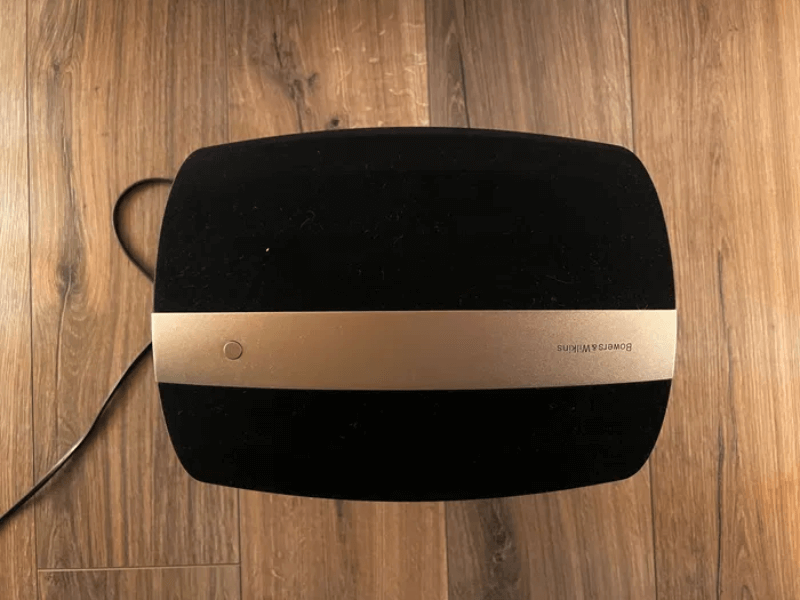
Bowers & Wilkin Formation Bass on The Floor
Alternatively, subwoofers like the Bowers & Wilkins Formation Bass transmit audio via WiFi. WiFi connects both the subwoofer and AV receiver or amplifier to your home network. Once connected, WiFi offers a wider range and also a higher bandwidth.
Wired vs. Wireless Subwoofers
Most subwoofers you’ll get in the market are wired. This requires you to have cables to connect them, which can sometimes limit the placement of the sub. However, with wireless subwoofers, you have the advantage of not having cables, which makes setup a breeze.
Wireless subwoofers are powered or active, so you’ll only need to plug in the power cable. Once connected, there’s hardly any difference in the sound quality between wired and wireless subwoofers. This is especially true if your wired subwoofer uses RF or WiFi connectivity. These two are harder to degrade and can transmit better audio signals.
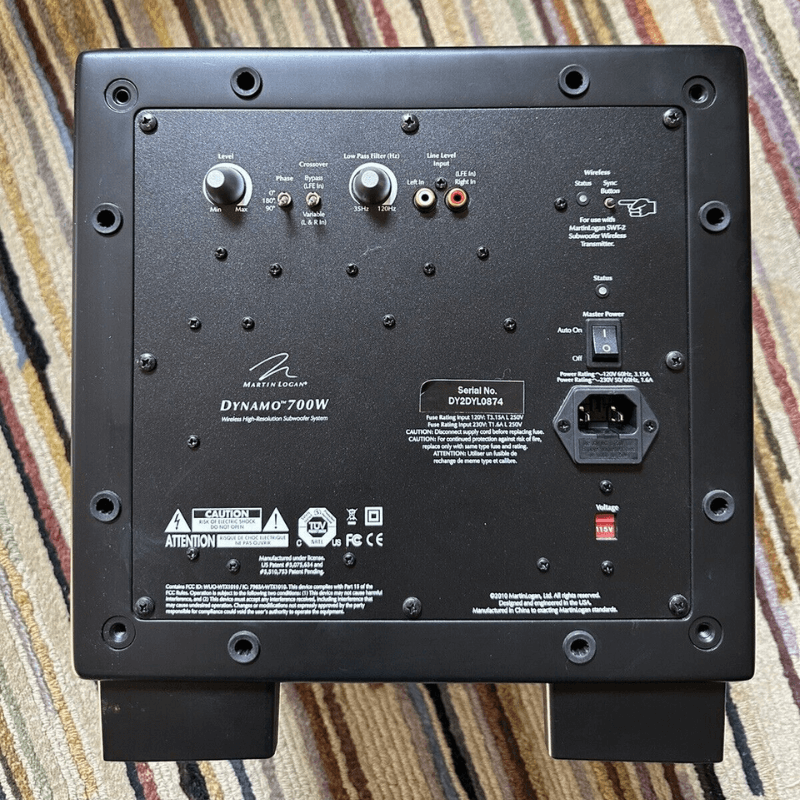
The Back Side of The MartinLogan Dynamo 700W
If you are planning to use a passive subwoofer, you cannot choose wireless subwoofers. Passive subwoofers require more cables to receive power and audio from the amp, unlike active subwoofers. However, if you own an active subwoofer, you can get a wireless subwoofer kit to turn it into a wireless subwoofer. We’ve got a deeper explanation of that below.
Wireless Subwoofer Kits Explained
If you own an active subwoofer, you can easily turn it into a wireless subwoofer by using a wireless subwoofer kit. Some good examples of wireless subwoofer kits include SVS SoundPath Wireless Audio Adapter and Klipsch WA-2 Wireless Subwoofer Kit.
For a wireless subwoofer kit to work, you need to first hook up the transmitter to your AV receiver, amplifier, or TV. The transmitter receives audio signals from your playback device and sends them to the receiver.
The receiver is plugged into the LFE input on your active subwoofer, which is the same input you insert the wire from your home theater setup. Once the receiver is inserted, turn on the transmitter and receiver to pair them.
The pairing process is done manually, but other subwoofer kits come already paired. If you follow the instructions correctly and the receiver and transmitter are paired, your audio should start flowing.
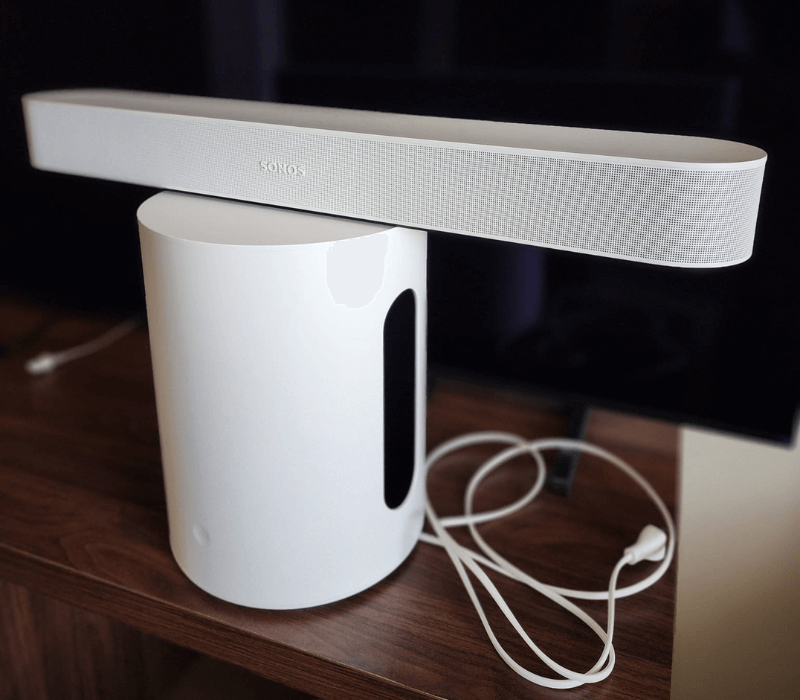
Setting Up Sonos Beam Gen 2 Soundbar and Sonos Sub Mini
Active vs. Passive Subwoofers
With wireless subwoofers, you only deal with active subwoofers. This is because an active subwoofer comes with an in-built amp and crossover circuitry that powers the subwoofer optimally. The good thing is that subwoofers out there are active subwoofers, so you don’t have to worry about amplifiers or power requirements.
However, with passive subwoofers, you’ll have to get your own powerful amplifier to power the sub. You’ll also have to make sure the amp is powerful enough to deliver sufficient power to your subwoofer and speakers. Fortunately, we have a guide on matching speakers and amps you can check out for more information. Check out this guide for a further reading on active and passive subwoofers.
Front- vs. Side- vs. Down-Firing
You’ve decided on a subwoofer; many different models are out there. Apart from wired and wireless or active and passive, subwoofers can further be broken down to the firing direction.
Figuring out which firing direction a subwoofer is in depends on the driver’s location or facing. A subwoofer driver that is on the front of the cabinet will be a front-firing subwoofer. When located at the bottom, Down-Firing. Side? Side-Firing. There are also inward-firing, such as the Sonos Sub Mini, which can be classified under side-firing.
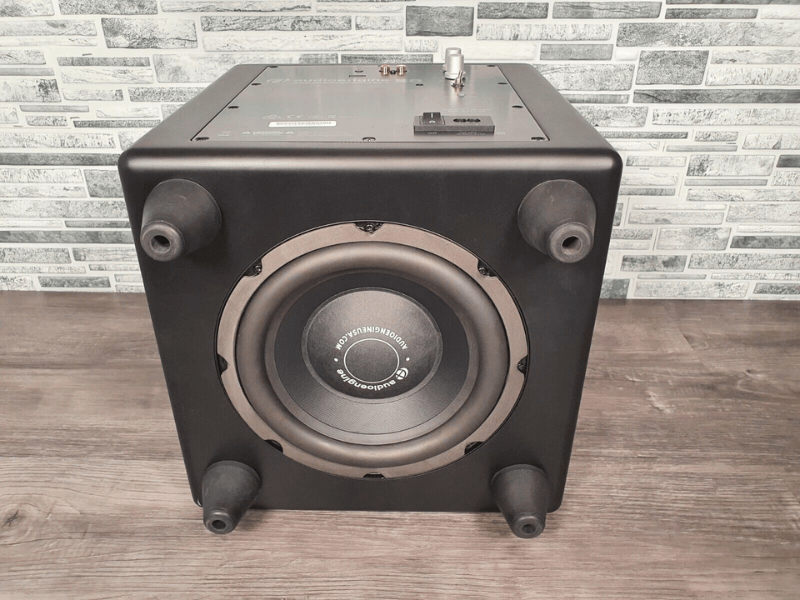
The Down Firing Driver of The Audioengine S8
The firing direction of a subwoofer only matters a little because bass frequencies are non-directions. No matter the firing direction, you’ll still feel the bass frequencies.
However, the firing direction can affect the placement of the subwoofer. If you plan to place the subwoofer next to your speakers, a side-firing sub will not be practical. Side-firing is also not a good option at the corner of a room, while front- or down-firing are better options.
Ported vs. Sealed Subwoofers Cabinets
If you thought we were done with classifying subwoofers, this is the last section! The subwoofer can further be divided into ported and sealed subwoofer.
Ported subwoofers come in a larger enclosure with one, two, or three ports in the design of the subwoofer enclosure. The ports in a ported subwoofer allow air to escape, which makes the subwoofer sound louder. However, they sound boomier and less accurate than sealed subwoofers and require more power.
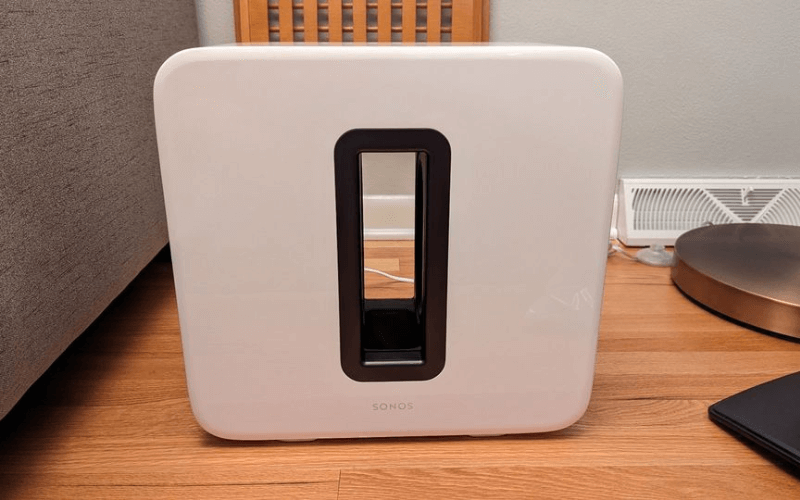
Sonos Sub – Gen 3 (White)
Sealed subwoofers are pretty explanatory because they lack the ports of a ported subwoofer. This means they can come in compact small-sized cabinets that can fit in a smaller space. Compared to ported subwoofers, sealed subwoofers produce a tight bass response which is more accurate. However, you’ll need more power and volume to produce more power than ported subwoofers.
Choosing between ported and sealed subwoofers will depend on various factors. For larger rooms, a ported subwoofer will deliver a more powerful sound, while a sealed subwoofer is great for smaller rooms. A sealed subwoofer is your best pick if you’re looking for bass accuracy, speed, and overall musicality.
Subwoofer Wattage Explained
If you skim through all our reviews of subwoofers, you’ll notice we insist and, when possible, indicate the wattage of the sub. This is because the wattage of a subwoofer will determine how long or more impactful it will be. The higher the wattage, the louder and more impactful a subwoofer will get.
However, you should note there are peak and RMS wattage. At HiFi Gear Lab, we insist on checking RMS and ignoring peak wattage.
RMS wattage (sometimes called continuous) refers to the overall power your subwoofer will always deliver at any time. However, peak power refers to the loudest the subwoofer will go when the volume is turned to the max.


